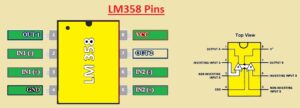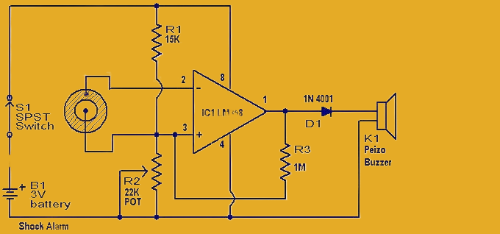 Hello, readers welcome to the new post. In this post, we will discuss the Introduction to LM358. LM358 is low power consuming less expensive dual-channel operational amplifier integrated circuit. It is constructed to operate through a single power supply at different values of volts. It standard operational amplifier and can be used for different electronic projects. It is small-size integrated circuitry.
Hello, readers welcome to the new post. In this post, we will discuss the Introduction to LM358. LM358 is low power consuming less expensive dual-channel operational amplifier integrated circuit. It is constructed to operate through a single power supply at different values of volts. It standard operational amplifier and can be used for different electronic projects. It is small-size integrated circuitry.
Its small size and less cost structure make it useful for different applications. In this post, we will discuss its working pinout and some other related parameters. So let’s get started Introduction to LM358
Introduction to LM358
- The LM358 is a dual-operational amplifier integrated circuit that comes with two operational amplifiers having one common power supply.
- It is like the half structure of the LM324 operational amplifier that has four operations amplifiers with a mutual power supply.
- The input volts are the same as the power supply voltage. The default input offset voltage is less about two millivolts.
- The normal input curent is about five hundred microamperes not depending on the supply volts value and the highest current of seven hundred microamperes.
- The operating temperature lies zero to seventy centigrade and the highest junction temperature can be about one fifty centigrade.
- The structure of this amplifier consists of active filters and transducer amplifiers.
LM358 Dual Op-Amp IC Features
- The main features of LM358 are explained here
- It comes in different packaging such as DSBGA, PDIP, SOIC, CDIP
- its soldering pin temperature is about two sixty centigrade
- The operating temperature is about zero to seventy centigrade
- It comes with short circuit protection output
- It has a single supply that can operate two operational amplifiers
- its low supply curent is 700uA
- It has two operational amplifiers in one packaging
- It has differnt power supply values
- Its single supply volts are three to thirty volts and double supply volts are ±1.5V to ±16V
LM358 Pins
- It comes with eight pinouts that is listed here
- Pin 1 is the output of operational amplifier one
- Pin 2 is the negative or inverting input of the first operational amplifier
- Pin 3 is the positive or non-inverting input of the first operational amplifier
- Pin 4 is the ground pin
- Pin 5 is the positive inverting input of the second operational amplifier
- Pin 6 is the negative input of the second operational amplifier
- Pin 7 is the output of the second amplifier
- pin 8 is the power supply pinout

Simple Shock alarm circuit using LM358
- The shock alarm circuitry is commonly used in vehicles and created through the use of LM358. It operates as an anti-theft alarm in vehicles. It uses piezoelectric sensors that operate as shock sensor which is mounted on the door that we have to guard
- In the below circuitry, LM348 is configured by inverting the Schmitt trigger. The R1 resistance adjusts the threshold voltage of the circuit. That operates as feedback resistance
- When the piezoelectric sensor does not activate the output though the piezoelectric sensor has a low value at this instant input is high and operates the Schmitt trigger in resulting sound produced through the buzzer
- The buzzer remains in operating condition for some time intervals when vibration is not connected. it is that inverting input has a small effect when LM358 I is triggered and the condition cannot be inverted easily. So there must be a strong connection between the sensor at the surface where it is installed.
LM358 IC Advantages
- It does not need the dual power supply for an operation which is the main benefit
- it comes with two operational amplifiers installed in its desing
- it has the ability to direct the sense of the ground and output
- It is best operated through the logic method
- It drains power accurately for the operation of the battery
LM358 IC Applications
- It used a dc gain block circuitry
- It is the main part of shock alarm circuitry and dark sensor circuits
- It used in transducer amplifier operation
- It used in the current loop transmitter for four to twenty milliampere
- It used in active filter
- it used as signal conditioning circuits
That is all about the LM358 all details has explained if you have any questions ask them here







